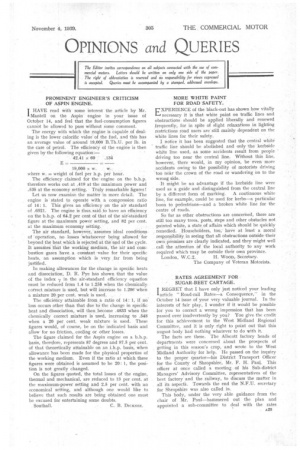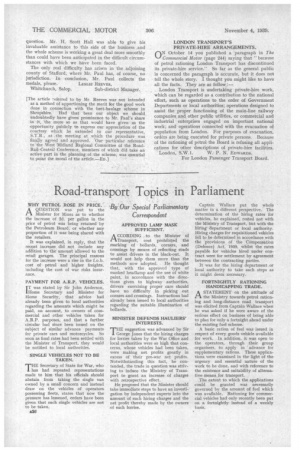OPINIONS and QUERIES
Page 35

Page 36

If you've noticed an error in this article please click here to report it so we can fix it.
PROMINENT ENGINEER'S CRITICISM OF ASPIN ENGINE.
I HAVE read with some interest the article by Mr. Mantell on the Aspin engine in your issue of October 14, and feel that the fuel-consumption figures cannot be allowed to pass without some comment.
The energy with which the engine is capable of dealing is the lower calorific value of the fuel, and this has an average value of around 19,000 B.Th.U. per lb. in the case of petrol. The efficiency of the engine is then given by the following equation: 42.41 x 60 .184 E= 19,000 x w. w.
where w. = weight of fuel per h.p. per hour.
The efficiency claimed for the engine on the b.h.p. therefore works out at .419 at the maximum power and .535 at the economy setting. Truly remarkable figures Let us now examine the matter in more detail. The engine is stated to operate with a compression ratio of 14: 1. This gives an efficiency on the air standard of .6521. The engine is thus,said to have an efficiency on the b.h.p. of 64.2 per cent of that of the air=standard figure at the maximum power setting, and 82 per cent. at the maximum economy setting.
The air standard, however, assumes ideal conditions of operation, no losses whatsoever being allowed for beyond the heat which is rejected at the end of the cycle. It assumes 'that the working medium, the air and combustion gases have a constant value for their specific heats, an assumption which is very far from being justified.
In making allowances for the change in specific heats and dissociation, D. R. Pye has shown that the value
of the index in the air-standard efficiency equation must be reduced from 1.4 to 1.258 when the chemically correct mixture is used, but will increase to 1.296 'when a mixture 20 per cent, weak is used.
The efficiency attainable from ,'a ratio of 1,4: I, if no loss occurs other than that due to the change in specific heat and dissociation, will then become .4833 when the chemically correct mixture is used, increasing to .548 when a 20 per cent, weak mixture is used. These figures would, of course, be on the indicated basis and allow for no friction, cooling or other losses.
The figure claimed for the Aspin engine on a b.h.p. basis, therefore, represents 87 degrees and 97.5 per cent. of that theoretically attainable on an i.h.p. basis, when allowance has been made for the physical properties of the working medium. Even if the ratio at which these figures were obtained is assumed to be 20:1, the position is not greatly changed.
On the figures quoted, the total losses of the engine, thermal and mechanical, are reduced to 13 per cent, at the maximum-power setting and 2.5 per cent, with an economical setting, and although one would like to believe that such results are being obtained one must be excused for entertaining some doubts, Southall. C. B. DICKSEE, MORE WHITE PAINT FOR ROAD SAFETY.
CXPERIENCE of the black-out has shown how vitally necessary it is that white paint on traffic lines and obstructions should be applied liberally and renewed frequently, for in spite of slight relaxations in lighting restrictions road users are still mainly dependent on the white lines for their safety.
I notice it has been suggested that the central white: traffic line should be abolished and only -the kerbside white line used, as some accidents result from people driving too near the central line. Without this line, however, there would, in my opinion, be even more accidents owing to the possibility of motorists driving too near the crown of the road or wandering o" ri to the wrong side.
It might be an advantage if the kerbside line were used as a guide and distinguished from the central line by a different form of marking. A continuous white line, for example, could be used for kerbs—a particular boon to pedestrians—and a broken white line for the centre of roads.
So far as other obstructions are concerned, there are still too many trees, posts, steps and other obstacles not .painted white, a state of affairs which should be quickly , remedied. Householders, too; have at least a moral responsibility in seeing that all obstructions outside •their own premises are clearly indicated, and they might well call the attention of the local authority to any work required which 'may be outside their own province.
London, W.C.2. H. WOOD, Secretary.
The Company of Veteran Motorists.
RATES . AGREEMENT FOR ' SUGAR-BEET CARTAGE.
REGRET that I have only just noticed your leading 'article "Road-rail Rates—a Consequence," in the October 14 issue of your very valuable journal. In the interests of fair play, I wonder if it would be possible for you to correct a wrong impression that has been passed oyer inadvertently by you? You give the credit for this achievement to the West Midland Regional Committee, and it is only right to point out that this august body had nothing whatever to do with it.
The facts are these. The Allscott factory heads of departments were concerned about the prospects of getting in this season's crop, and wrote to the West Midland Authority for help. He passed on the inquiry to the proper quarter—his District Transport Officer for the County of Shropshire, Mr. F. H. Paul. This officer at once called a meeting of his Sub-district Managers' Advisory Committee, representatives of the beet factory and the railway, to discuss the matter in all its aspecfs. Towards the end the N.F.U. secretary for Shropshire was also called in.
This body, under the very able guidance from the chair of Mr. Paul—hammered out the plan and appointed a sub-committee to deal with the rates A25
question. Mr. H. Scott Hall was able to give his invaluable assistance to this side of the business and the whole scheme is working a great deal more smoothly than could have been anticipated in the difficult circumstances with which we have been faced.
The only real difficulty has arisen in the adjoining county of Stafford, where Mr. Paul has, of course, no jurisdiction. In conclusion, Mr. Paul collects the medals, please. LESLIE REEVES, VVhitchurch, Salop. Sub-district Manager.
[The article -eferred to by Mr. Reeves was not intended as a method of apportioning the merit for the good work done in connection With the beet-haulage sehenie in Shropshire. Had that been our object we should undoubtedly have given prominence to Mr. Paul's share in it, the more so as. that would have given us the opportunity publicly to express our appreciation of the courtesy which he extended to our representative, S.T.R., at the meeting at which the procedure was finally agreed and approved. Our particular reference to the West Midland Regional Committee of the RoadRail Central Conference, members of which did take an active part in the planning of tbe scheme; was essential to point the moral of the article.—ED.}
LONDON TRANSPORT'S PRIVATE-HIRE ARRANGEMENTS.
ON October 14 you published a paragraph in The Commercial Motor (page 244) saying that "because of petrol rationing London Transport has discontinued its private-hire service." So far as the general public is concerned the paragraph is accurate, but it does not tell the whole story. I thought you might like to have all the facts. They are as follow:—
London Transport is undertaking private-hire work, which can be regarded as a contribution to the national effort, such as operations to the order of Government Departments or local authorities; operations designed to assist the proper functioning of the main-line railway companies, and other public utilities, or commercial and industrial enterprises engaged on important national work; and operations connected with the evacuation of population from London. For purposes of evacuation, orders are being executed for private persons. Because of the rationing of petrol the Board is refusing all applications for other descriptions of private-hire facilities.
London, S.W.1. W. P. N. EDVV'ARDS.
For London Passenger Transport Board.




























































